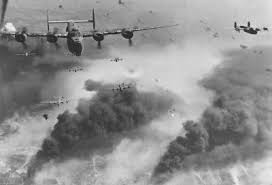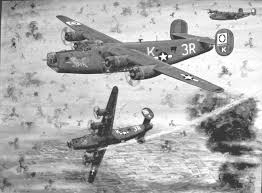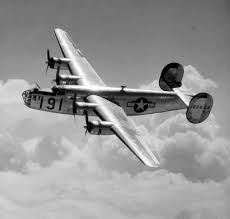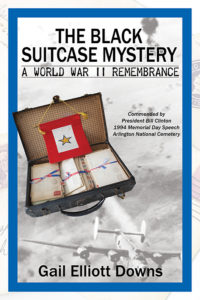Information taken from the prologue of The Wild Blue: The Men and Boys Who Flew the B-24s over Germany by Stephen Ambrose.
The B-24 was built like a Mack Truck, except that it had an aluminum skin that could be cut with a knife. It could carry a heavy load far and fast but it had no refinements. Steering the four-engine airplane was difficult and exhausting, as there was no power except the pilot’s muscles. It had no windshield wipers, so the pilot had to stick his head out the side window to see in the rain. Breathing was possible only by wearing an oxygen mask—cold and clammy, smelling of rubber and sweat—above 10,000 feet in altitude. There was no heat, despite temperatures that at 20,000 feet and higher got as low as 40 or even 50 degrees below zero. The wind blew through the airplane like a fury, especially from the waist gunners’ windows and whenever the bomb bay doors were open. The oxygen mask often froze to the wearer’s face. If the men at the waist touched their machine guns with bare hands, the skin froze to the metal.
There were no bathrooms. To urinate there were two small relief tubes, one forward and one aft, which were almost impossible to use without spilling because of the heavy layers of clothing the men wore. Plus which the tubes were often clogged with frozen urine. Defecating could be done in a receptacle lined with a wax paper bag. A man had to be desperate to use it because of the difficulty of removing enough clothing and exposing bare skin to the arctic cold. The bags were dropped out of the waist windows or through the open bomb bay doors. There were no kitchen facilities, no way to warm food or coffee, but anyway there was no food unless a crew member had packed in a C ration or a sandwich. With no pressurization, pockets of gas in a man’s intestinal tract could swell like a balloon and cause him to double over in pain.
There was no aisle to walk down, only the eight-inch-wide catwalk running besides the bombs and over the bomb bay doors used to move forward and aft. It had to be done with care, as the aluminum doors, which rolled up into the fuselage instead of opening outward on a hinge, had only a 100-pound capacity, so if a man slipped he would break through. The seats were not padded, could not be reclined, and were cramped into so small a space that a man had almost no chance to stretch and none whatsoever to relax. Absolutely nothing was done to make it comfortable for the pilot, the co-pilot or the other eight men in the crew, even though most flights lasted for eight hours, sometimes ten or more, seldom less than six.
It was called a Liberator. Consolidated Aircraft Corporation, along with the Ford Motor Company, Douglas Aircraft Company, and North American Aviation—together called the Liberator Production Pool—made more than 18,300 Liberators, about 5,000 more than the total number of B-17s. The Liberator was not operational before World War II and was not operational after the war (nearly every B-24 was cut up into pieces of scrap in 1945 and 1946, or left to rot on Pacific islands). The number of people involved in making it, servicing it, and in flying the B-24 outnumbered those involved with any other airplane, in any country, in any time. There were more B-24s than any other America airplane ever built.





